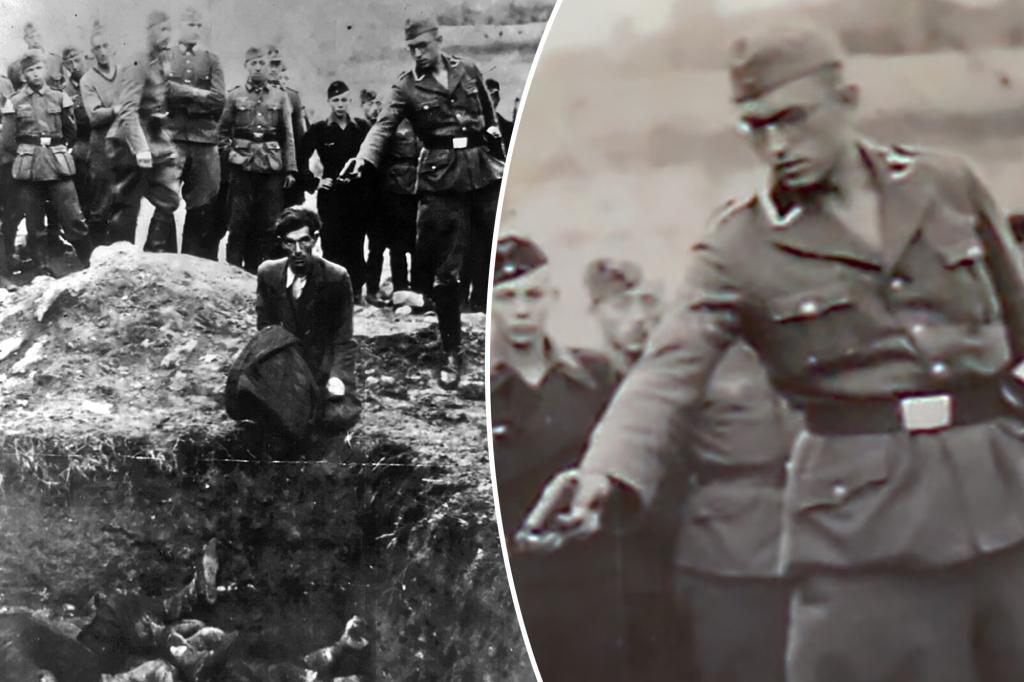AI Helps Identify Nazi Executioner in Infamous WWII Photo After 80 Years
2 Sources
2 Sources
[1]
Name of Nazi executioner in horrific WWII photo revealed using AI...
Often associated with scams and deepfakery, AI is now being used for another, more noble purpose: unmasking history's monsters. A German historian has utilized the omnipresent tech to glean the identity of a notorious Nazi executioner in a World War II photograph -- over 80 years after it was taken. "The match, from everything I hear from the technical experts, is unusually high in terms of the percentage the algorithm throws out there," German historian Jürgen Matthäus, the sleuth who solved the mystery, told the Guardian. In the chilling photo, taken in today's Ukraine, a bespectacled Nazi soldier aims a pistol at a man in suit who's kneeling before a mass grave as other SS troops look on. Commonly known as the "Last Jew of Vinnitsa," the pic remained a mystery for decades until Matthäus cracked the caper with the aid of AI, historical records and personal accounts a puzzling over the photo for years up to that point. According to the study published in the Journal of Historical Studies, the massacre took place on July 28, 1941 in the citadel of Berdychiv and not Vinnitsa as previously thought. The regiment, Einsatzgruppe C had reportedly been charged with eradication of "Jews and partisans" in the newly-occupied Soviet region ahead of a visit by Adolf Hitler. Meanwhile, the gunman is believed to be Jakobus Onnen, a French, English and gym teacher who was born 1906 in Tichelwarf, Germany and joined the Nazi party in 1931. Matthäus happened upon this alleged revelation in part due to a stroke of luck, when, after word of the massacre's real whereabouts, date and unit circulated German media last year, a reader came forward with some vital information. Based on correspondence from the time in his family's possession, he said that the shooter bore a striking resemblance to his wife's uncle, Onnen, and provided the aforementioned biographical details. The pics were then sent to open-source journalism group Bellingcat volunteers, who were able to forensically analyze it using AI. When coupled with the strong likeness and strong circumstantial evidence, it seemed like a perfect enough match to publish, per Matthäus. While AI was undoubtedly integral in this historic eureka moment, Matthäus maintained that the tech is "not the silver bullet" but "one tool among many" and that "the human factor remains key." It's yet unclear what prompted Onnen to radicalize, but he was reportedly a dedicated Nazi. In August 1939, just before the outbreak of war, he enlisted in the SS Death's Head Unit at Dachau concentration camp and was working for the Nazi "Order Police" in occupied Poland by 1940, the Independent reported. He then joined the Einsatzgruppe C -- with whom he'd be snapped carrying out his horrific execution -- in 1941, shortly after the Nazi invasion of the Soviet Union. The unit reportedly eliminated all but 15 of the 20,000 Jews that were there upon their arrival. "These mass executions in this format continued until the very last day of the German occupation in the east," Matthäus said. "I think this image should be just as important as the image of the gate in Auschwitz, because it shows us the hands-on nature, the direct confrontation between killer and person to be killed." Despite his fervor, Onnen reportedly was never promoted beyond a low rank and was killed fighting partisans in the Zhytomyr region of Ukraine in 1943. Unfortunately, his kneeling victim has yet to be identified, but Matthäus said he plans to remedy that as part of his next project using Soviet-era records and, possibly, the aid of AI.
[2]
Name of Nazi executioner in horrific WWII photo revealed using AI
Often associated with scams and deepfakery, AI is now being used for another, more noble purpose: unmasking history's monsters. A German historian has utilized the omnipresent tech to glean the identity of a notorious Nazi executioner in a World War II photograph -- over 80 years after it was taken. "The match, from everything I hear from the technical experts, is unusually high in terms of the percentage the algorithm throws out there," German historian Jürgen Matthäus, the sleuth who solved the mystery, told the Guardian. In the chilling photo, taken in today's Ukraine, a bespectacled Nazi soldier aims a pistol at a man who's kneeling before a mass grave as other SS troops look on. Commonly known as the "Last Jew of Vinnitsa," the pic remained a mystery for decades until Matthäus cracked the caper with the aid of AI, historical records and personal accounts. According to the study published in the Journal of Historical Studies, the massacre took place July 28, 1941 in the citadel of Berdychiv and not Vinnitsa as previously thought. The regiment, Einsatzgruppe C, had reportedly been charged with eradication of "Jews and partisans" in the newly occupied Soviet region ahead of a visit by Adolf Hitler. The gunman is believed to be Jakobus Onnen, a French, English and gym teacher who was born in 1906 in Tichelwarf, Germany, and joined the Nazi party in 1931. Matthäus happened upon this revelation in part due to a stroke of luck, when, after word of the massacre's real whereabouts, date and unit circulated in German media last year, a reader came forward with some vital information. Based on correspondence from the time in his family's possession, he said that the shooter bore a striking resemblance to his wife's uncle, Onnen, and provided the aforementioned biographical details. The pics were then sent to open-source journalism group Bellingcat volunteers, who were able to forensically analyze it using AI. When coupled with the strong likeness and strong circumstantial evidence, it seemed like a perfect enough match to publish, per Matthäus. While AI was undoubtedly integral in this historic eureka moment, Matthäus maintained that the tech is "not the silver bullet" but "one tool among many" and that "the human factor remains key." It's not clear what prompted Onnen to radicalize, but he was reportedly a dedicated Nazi. In August 1939, just before the outbreak of war, he enlisted in the SS Death's Head Unit at Dachau concentration camp and was working for the Nazi "Order Police" in occupied Poland by 1940, the Independent reported. He then joined the Einsatzgruppe C -- with whom he'd be snapped carrying out his horrific execution -- in 1941, shortly after the Nazi invasion of the Soviet Union. The unit reportedly eliminated all but 15 of the 20,000 Jews that were there upon their arrival. "These mass executions in this format continued until the very last day of the German occupation in the east," Matthäus said. "I think this image should be just as important as the image of the gate in Auschwitz, because it shows us the hands-on nature, the direct confrontation between killer and person to be killed." Despite his fervor, Onnen reportedly was never promoted beyond a low rank and was killed fighting partisans in the Zhytomyr region of Ukraine in 1943. Unfortunately, his kneeling victim has yet to be identified, but Matthäus said he plans to remedy that as part of his next project using Soviet-era records and, possibly, the aid of AI.
Share
Share
Copy Link
German historian Jürgen Matthäus uses AI technology to uncover the identity of a Nazi executioner in a haunting World War II photograph. The discovery showcases the potential of AI in historical research and corrects long-held misconceptions about the image.

AI Unveils Identity of Nazi Executioner in Infamous WWII Photograph
In a groundbreaking application of artificial intelligence, German historian Jürgen Matthäus has successfully identified a Nazi executioner in a haunting World War II photograph, more than 80 years after it was taken. This development showcases how AI technology can be utilized for historical research and uncovering long-hidden truths
1
2
.The Chilling Photograph
The photograph in question, commonly known as the "Last Jew of Vinnitsa," depicts a bespectacled Nazi soldier aiming a pistol at a kneeling man in front of a mass grave, while other SS troops look on. This image, taken in what is now Ukraine, has long been a symbol of the Holocaust's brutality
1
2
.The Power of AI in Historical Research
Matthäus's investigation combined AI technology with traditional historical research methods. The breakthrough came when a reader of German media provided crucial information based on family correspondence. The photograph was then analyzed by volunteers from Bellingcat, an open-source journalism group, using AI-powered forensic analysis
1
2
.Matthäus emphasized that while AI was integral to this discovery, it is "not the silver bullet" but rather "one tool among many," stressing that "the human factor remains key" in historical research
1
2
.The Identified Executioner: Jakobus Onnen
The Nazi soldier in the photograph has been identified as Jakobus Onnen, born in 1906 in Tichelwarf, Germany. Onnen was a French, English, and gym teacher who joined the Nazi party in 1931. His path to radicalization led him to enlist in the SS Death's Head Unit at Dachau concentration camp in August 1939, just before the outbreak of World War II
1
2
.Correcting Historical Inaccuracies
The research has also corrected some long-held misconceptions about the photograph. The massacre depicted actually took place on July 28, 1941, in the citadel of Berdychiv, not in Vinnitsa as previously believed. The unit responsible was Einsatzgruppe C, tasked with the eradication of "Jews and partisans" in the newly-occupied Soviet region ahead of a visit by Adolf Hitler
1
2
.Related Stories
The Significance of the Discovery
Matthäus believes this image should be considered as important as the iconic image of the gate at Auschwitz. He argues that it "shows us the hands-on nature, the direct confrontation between killer and person to be killed," providing a stark representation of the Holocaust's brutality
1
2
.Future Research
While the identity of the executioner has been revealed, the kneeling victim remains unidentified. Matthäus plans to continue his research, aiming to identify the victim using Soviet-era records and potentially employing AI technology once again
1
2
.This breakthrough demonstrates the potential of AI in historical research, offering new possibilities for uncovering and understanding the past. As technology continues to advance, it may play an increasingly significant role in revealing hidden aspects of history and bringing closure to long-standing mysteries.
References
Summarized by
Navi
[1]
Related Stories
Recent Highlights
1
Google launches Gemini 3 Flash as default AI model, delivering speed with Pro-grade reasoning
Technology

2
OpenAI launches GPT Image 1.5 as AI image generator war with Google intensifies
Technology

3
OpenAI launches ChatGPT app store, opening doors for third-party developers to build AI-powered apps
Technology








